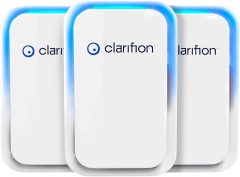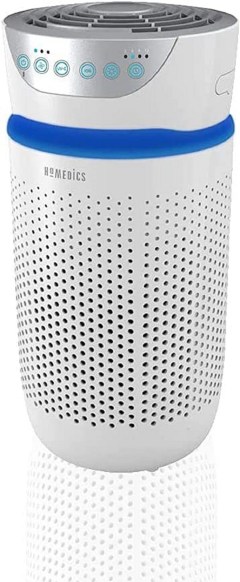Buying guide for best air ionizers
The best way to get clean air in your home is to eliminate pollutants at the source, but that isn’t practical if the source is your kitchen or beloved pet. The next best thing to do is get fresh air in and vent bad air out, but that isn’t feasible if there’s wildfire smoke or a blizzard outside. Cleaning the air you have is your next most effective option, and one way to help get your indoor air cleaner is to use an air ionizer.
An air ionizer creates negative ions that bind to particulate matter in the air, making them more likely to cling to walls, floors, furniture and each other so they can be filtered, swept or washed away. Ionizers work best for extremely tiny particles that regular filters might not catch. This clumping effect is an ionizer’s main benefit.
There are plenty of health claims about ionized air, some helpful, some less so. There’s evidence that ionization inhibits the growth of airborne microorganisms like bacteria, viruses and mold spores, especially in hospital settings, and some studies on its positive health effects in people. Ionizers are also less effective on larger particles like pollen or dander, and they don’t affect levels of gasses like carbon monoxide, carbon dioxide or radon. Ionizers also create ozone, which is great up in the stratosphere but harmful for humans and most animals to breathe, and it doesn’t clean the air.
An air purifier is generally a better choice to clean indoor air than a standalone air ionizer, and several of our picks are air purifiers that also ionize air. If you already have an air purifier, or want to try out air ionization to see if it makes a difference for you, we suggest the convenient and popular Clarifion plug-in air ionizer, while the slightly more expensive Clarifion DSTx portable model is a good value.
Expert tip
Be very mindful of the features you purchase and follow use guidelines - use of ozone generators requires special care.
BestReviews Home Improvement and DIY Expert
Best air ionizers
This Clarifion ionizer (model GL-139) is riding high on a wave of popularity. Unlike other air ionizers, it’s small, light and unobtrusive, the size and shape of a plug-in air freshener. Fanless and filterless, it makes no noise and needs no upkeep, but you need to remember to clean off the ionized dust that builds up near it on the wall.
While it’s difficult to find information on the amount of ozone the Clarifion generates, it’s been approved for sale in California, which has some of the highest air quality regulations in the country. One Clarifion unit costs around $40, but you’ll probably need at least three to make a noticeable difference in your home.
If you also want to filter the air, consider the Clarifion DSTx portable air purifier. Just like the original Clarifion, it plugs into a wall socket, so you don’t have to worry about making space for it on a table or counter. The Clarifion DSTx includes a HEPA filter, an activated carbon filter and a dual-speed fan, so it can remove the particles it ionizes as well as larger particulates like allergens, and it absorbs odors and smoke.
It’s certified by the California Air Resources Board (CARB), meaning it doesn’t produce harmful levels of ozone. You can also change the brightness of its blue function light or turn it off, which is ideal if you want to use it in a bedroom at night. This unit is suitable for bedrooms and other smaller rooms.
The HoMedics TotalClean is a full-size air purifier that combines five functions, including ionization. It takes in air from all around its tower, passes it through a prefilter, HEPA-type filter and carbon filter, while bathing the air in germicidal UVC light and ionizing the air as it vents. As an air purifier, the small HoMedics has a clean air delivery rate (CADR) of 159, which is suitable for rooms up to 170 square feet, such as bedrooms or bathrooms.
Note that a HEPA-type filter is not the same as a true HEPA filter, but the HoMedics UVC light is a known way to disinfect microbes that get through the fibers of the HEPA-type filter.
Another tower air purifier that includes an ionizer, the PureZone Elite uses ionization as an optional feature you can activate as desired. It has a true HEPA filter that catches 99.97% of particulates and allergens in the air, an activated carbon filter for odors and a UVC germicidal light to sanitize the air as it passes through.
We like that the PureZone Elite has an air quality detector that automatically adjusts the fan speed. The large-room model has a CADR of 120, which Pure Enrichment promises can purify a 990-square-foot space in an hour, but for faster air exchange, a smaller room of around 200 square feet is best.
It isn’t going to win many points for looks, but the utilitarian Holmes desktop air purifier does the job. It has no fancy bells and whistles, just switches that set the fan speed and turn the ionizer on or off. This Holmes model can be set horizontally or vertically, giving it some flexibility in terms of placement. Its size and smoke CADR of 70 makes it suitable for bedrooms and other smaller rooms.
There are several kinds of filters available for the Holmes, allowing you to customize the filtration to suit your needs, such as a filter designed for odor elimination or a true HEPA filter with superior filtration. We like that the Holmes provides the ability to turn the ionizer on or off and that the filters are easy to find.
Unlike some manufacturers, InvisiClean lists its Aura II air purifier’s vital stats right on its product page: a 171 maximum CADR rating that allows for 4.8 air exchanges per hour in a 228-square-foot room (or 1 air exchange per hour in a 1,000-square-foot space or larger); a true HEPA filter that catches 99.985% of particulates; a UVC light in the highly effective 257 nm wavelength; and an acknowledgement that its ionizer is designed to make particles clump together for easier filtration and not anything else. It also doesn’t shy away from proclaiming it’s certified for sale in California and meets ozone health limits. It has four fan speeds, a combined charcoal filter/prefilter and a quiet sleep mode.
Expert tip
For max results, your ionizer should be left to run 24/7.
BestReviews Home Improvement and DIY Expert
What to know before buying an air ionizer
Collecting and removing ionized particles
All that ionized particulate matter that falls out of the air needs to go somewhere. It doesn’t just magically disappear. If you use an air ionizer to remove cigarette smoke, for example, you may see a lot more dust and grime because the ionizer has caused the smoke particles to clump and collect on the floor, walls or furniture. Dusting, vacuuming and running an air purifier are ways to remove the resulting dirt.
Coverage area
If you’re investing in an air purifier with an ionizer feature, check the size of the unit’s coverage area. Air purification devices only work efficiently in one room, so unless your home is one giant room, its total square footage is less important than the square footage of the room the unit is in. A typical U.S. bedroom is between 125 and 250 square feet, while kitchens can range from 100 square feet in an apartment to 360 square feet or bigger. If available, a device’s CADR, air exchange frequency and cubic feet per minute (cfm) ratings are also helpful in this regard.
Certifications for ozone
The California Air Resources Board (CARB) maintains a list of certified portable indoor air cleaning devices that can be sold to California consumers or businesses. When it comes to ionizers and ozone generators, a device must have an ozone emission concentration limit at or below 0.050 parts per million (or 50 parts per billion). Devices that produce more than this cannot be sold or shipped to California. CARB certification is a quick way to determine if an air ionizer produces low levels of ozone. Another similar resource is the list of certified room air cleaners published by the Association of Home Appliance Manufacturers (AHAM).
Health benefits
Although air ionizers can be used for general air purifying purposes, you might buy one to help resolve a certain issue, such as reducing hay fever or dust allergy symptoms, although it’s possible some of the relief might be due to the placebo effect. Ionizers can remove smoke particles from the air, so they're useful if you want to lessen the impact of smoking in your home. Some studies suggest improved mood with the use of ionization, but the results are inconclusive.
Noise
A standalone air ionizer is extremely quiet, but air purifiers have a fan that makes noise. The more powerful the air purifier, the larger the fan and the louder it will be. If having a quiet air ionizer is important to you, look for one that does not have additional filtration devices or check the noise level before buying.
Expert tip
Order genuine, branded replacement filters for best results. Some manufacturers can void warranties if their brand of filters are not used.
BestReviews Home Improvement and DIY Expert
FAQ
Q. How much does an air ionizer cost?
A. You can find basic plug-in air ionizers for as little as $15, but the usefulness and quality of these cheap devices are questionable. For $40 to $100, you can find more reputable models, including small air purifiers suitable for bedrooms and bathrooms. High-end air purifiers that cost $100 to $300 usually include a wide range of purification methods (such as HEPA filtration and UV light) and may have larger coverage areas.
Q. Do air ionizers really work?
A. Ionizers work if you expect them to help remove fine particles from the air. By themselves, they don’t collect that matter or filter it. Ionizers can help remove odor-causing particles or cigarette smoke, but it’s inconclusive whether they remove larger allergens. Other claims made for air ionizers are somewhat doubtful.
Q. Do air ionizers cost much to run?
A. An air ionizer won't add much to your utility bill. A standalone air ionizer like the Clarifion plug-in uses 3.5 watts, less than a small USB charger. Some air purifiers, such as the InvisiClean Aura II, have an energy-saving mode that uses as little as 3 watts and more effective high-fan modes that go up to 30 to 45 watts. For more on filter replacement and other air purifier costs, see our air purifier buying guide.































